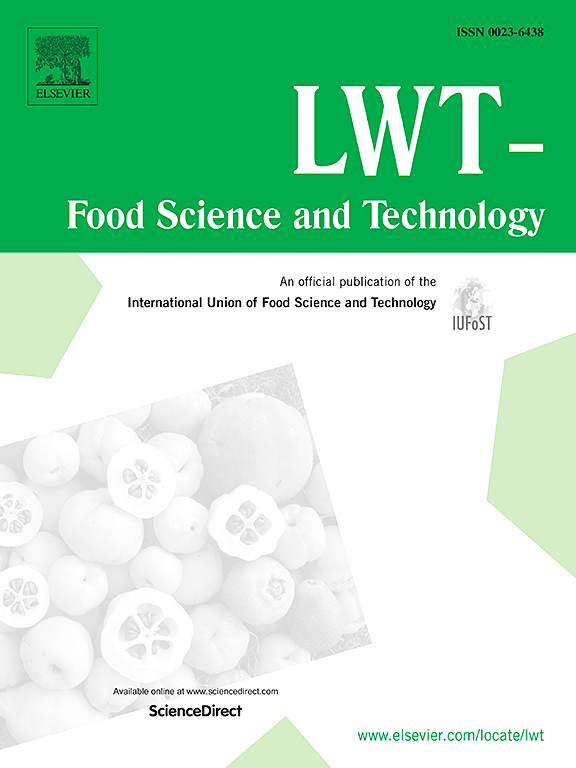探索牛奶酸乳酒糟发酵改善酸果汁适口性的机理
IF 6.6
1区 农林科学
Q1 FOOD SCIENCE & TECHNOLOGY
引用次数: 0
摘要
酸果蔓含有丰富的营养物质和生物活性化合物。然而,由于其强烈的涩味和苦味,人们并不普遍食用。本研究的目的是通过用牛奶酸乳酒糟(MKG)发酵来改善酸果蔓汁的适口性。本研究还试图考察在 MKG 发酵过程中(0、24 和 48 小时)酸果果汁的理化性质、感官评分、微生物组成以及挥发性和非挥发性化合物的变化。结果表明,醋酸杆菌、乳酸杆菌和卡扎克斯坦尼亚诱导的总酚和总抗氧化活性(DPPH、FRAP、ABTS)增加,聚合原花青素减少,导致发酵果汁(48 小时)的涩味和苦味低于未发酵果汁(0 小时)。此外,气相色谱-质谱(GC-MS)分析表明,MKG 发酵提高了醇、酸和酯的含量,同时降低了苯甲醛和二氯甲烷的浓度。基于 LC/MS 的非靶向代谢组学分析显示,发酵果汁中各种小分子量化合物(包括多酚、有机酸和醛类)的相对含量显著增加。这些研究结果表明,MKG 发酵是一种很有前景的技术,可提高酸果汁的整体可接受性。本文章由计算机程序翻译,如有差异,请以英文原文为准。
Exploring the mechanism of milk kefir grain fermentation to improve the palatability of chokeberry juice
Chokeberry is a rich source of nutrients and bioactive compounds. Nevertheless, it is not popularly consumed due to its strong astringency and bitterness. The objective of this study was to improve the palatability of chokeberry juice through fermentation with milk kefir grains (MKG). The study also sought to examine the changes in physicochemical properties, sensory scores, microbial compositions, and volatile and non-volatile compounds of chokeberry juice during MKG fermentation (0, 24 and 48 h). The results demonstrated that an increase in total phenols and total antioxidant activities (DPPH, FRAP, ABTS), and a decrease in polymeric proanthocyanidins, induced by Acetobacter, Lactobacillus and Kazachstania, led to a fermented juice (48 h) with lower astringency and bitterness compared with the non-fermented one (0 h). Furthermore, the gas chromatography-mass spectrometry (GC-MS) analysis demonstrated that the MKG fermentation led to improvements in the levels of alcohols, acids and esters, while concomitantly reducing the concentrations of benzaldehyde and methylene chloride. The LC/MS-based untargeted metabolomics analysis revealed notable increases in the relative levels of various compounds with small-molecular weights in the fermented juice, including polyphenols, organic acids and aldehydes. These findings indicate that MKG fermentation is a promising technique for enhancing the overall acceptability of chokeberry juice.
求助全文
通过发布文献求助,成功后即可免费获取论文全文。
去求助
来源期刊

LWT - Food Science and Technology
工程技术-食品科技
CiteScore
11.80
自引率
6.70%
发文量
1724
审稿时长
65 days
期刊介绍:
LWT - Food Science and Technology is an international journal that publishes innovative papers in the fields of food chemistry, biochemistry, microbiology, technology and nutrition. The work described should be innovative either in the approach or in the methods used. The significance of the results either for the science community or for the food industry must also be specified. Contributions written in English are welcomed in the form of review articles, short reviews, research papers, and research notes. Papers featuring animal trials and cell cultures are outside the scope of the journal and will not be considered for publication.
 求助内容:
求助内容: 应助结果提醒方式:
应助结果提醒方式:


